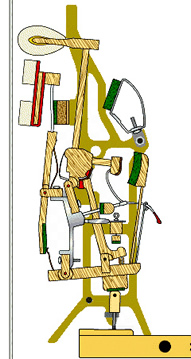Chaz Hawley - Tuning, Voicing, Regulating & Repairs. . . Since 1977
Call or Text me » (650) 438-8334 • 10AM to 9PM. . . I do work on weekends!
Email me » crh@ichaz.com
| |
Background:
 I learned the piano craft as an apprentice back in the mid 70's in a prestigious rebuilding shop. I worked there about 2 years under the direction of local I learned the piano craft as an apprentice back in the mid 70's in a prestigious rebuilding shop. I worked there about 2 years under the direction of local  Piano legend Bob Burton. There I learned all the kinds of repairs, adjustments, complete rebuilding everything from historic nineteenth century antiques to modern top-quality concert grands. Since starting my own business in 1977, I have tuned and serviced all styles and sizes of pianos. I have completely rebuilt and refinished many grands, Steinway, Bechstein and Bösendorfer. I am also one of the few technicians who will work on Square Grands and Birdcages, those now rare antiques that have somehow survived from the 1830′s to the 1890's. No matter what the age, condition or quality of your piano, I always endeavor to make my customers completely happy! Piano legend Bob Burton. There I learned all the kinds of repairs, adjustments, complete rebuilding everything from historic nineteenth century antiques to modern top-quality concert grands. Since starting my own business in 1977, I have tuned and serviced all styles and sizes of pianos. I have completely rebuilt and refinished many grands, Steinway, Bechstein and Bösendorfer. I am also one of the few technicians who will work on Square Grands and Birdcages, those now rare antiques that have somehow survived from the 1830′s to the 1890's. No matter what the age, condition or quality of your piano, I always endeavor to make my customers completely happy!
Techniques:
I am tuning with a combination of ear and advanced digital tuning devices. My ear is always able to detect situations where I need to overide the digital info. With this combination, I can achieve the most stable and pleasing results – creating a special Temperament & Stretch 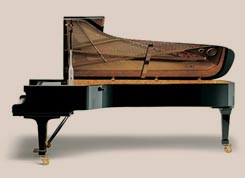 which is customized for the unique scale of each piano. Normal tunings are guaranteed to last for 6 months. ("Normal" means pianos that were tuned within 2 years, and/or don't need a Pitch-Raise.... See more ») which is customized for the unique scale of each piano. Normal tunings are guaranteed to last for 6 months. ("Normal" means pianos that were tuned within 2 years, and/or don't need a Pitch-Raise.... See more »)
I will gladly come back and "touch up" individual notes if they have drifted during that time. I have rarely been called back. I spend a full 2 hours or more and carefully set each of the 230+ strings & tuning pins for optimal stability. i can also tweak the ends of the string to supress unwanted sound distortions. My tunings sound quite good even a year or two later, unless there are unusual shifts in humidity or temperature in the piano's enviornment.
Voicing:
I can also expertly Voice your piano... soften the notes that are too harsh, or brighten those that are too soft, thereby creating an evenness of expression across the whole keyboard. Having extensive technical knowledge, I can quickly solve issues concerning regulation, hammer alignment, uneven string height, malfunctioning dampers, sticking or jamming keys, unwanted noises and squeaks, pedal adjustments, etc.
I can often remove false beats, the common anomaly that plagues the alto and soprano sections of most pianos. This causes individual strings to repeatedly switch between oscillation directions. So on a grand piano the string starts with vertical motion and switches to horizontal and back and forth, usually many times per second. This phenomenon creates a slightly out-of-tune sound or pulsing effect that sometimes blends away once all 3 strings are playing in tune. Often there are a couple strings in a note that have this issue. Not always but often these beats can be alleviated by slightly changing the string bend at the bridge, or the height against the bridge, or rotating the bridge pin. Also helpful is introducing a bend or compression at the capo bar or "nut" and even repositioning the string sideways ever so sightly. Only rarely do I find a piano with absolutely no false beats.
Pitch Raise: (Read about 440 VS 432»)
Over the years I have perfected a 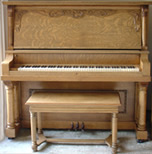 technique to deal with those most neglected pianos that have been unused for decades, and are a note flat. I can do an extreme Pitch-Raise [50-100 cents] with a single tuning all in one pass. I often go over several notes twice but generally get everything within a few cents. This kind of tuning usually takes 3 or more hours. But instead of insisting that the piano needs 2 or more tunings that same day, I can save the second tuning for 3 to 7 months later when the piano will then be settled down enough so that the next tuning can then be quite stable. See more on Pitch Raises» technique to deal with those most neglected pianos that have been unused for decades, and are a note flat. I can do an extreme Pitch-Raise [50-100 cents] with a single tuning all in one pass. I often go over several notes twice but generally get everything within a few cents. This kind of tuning usually takes 3 or more hours. But instead of insisting that the piano needs 2 or more tunings that same day, I can save the second tuning for 3 to 7 months later when the piano will then be settled down enough so that the next tuning can then be quite stable. See more on Pitch Raises»
|
| |
|
~~~~~~~~~~~~~~~~~~~~~~~~~~~~~~~~~~~~~~~~~~~~~~~~~~~~~~~~~~~~~~~~~~~~~~~~~~~~~~~~~~~
MORE ABOUT BAY PIANO TUNER
Spring-Loaded Tunings:
I am keenly aware of the various stresses on strings as they go through the different sections of the piano. I can therefore "spring load" my tunings. In the chart below, there are two non-speaking sections in red. 1) Where strings are between the Tuning Pins and the Capo Bar, and 1) between the Bridge and the Hitch Pins, these are the non-speaking areas. In the Alto and Soprano sections, the strings have more non-speaking length than speaking length. By slightly raising tension in these silent areas, strings can be tuned in such a way as to maximize stability. Because of the bending of a string during loud playing, the 150 lbs of tension on a string is increased by a few pounds.  When that tension exceeds the non-speaking area's tension, and when the friction of the capo bar and bridge give way, then the string will go a little flat each time the note is played loudly. By slightly increasing these non-speaking area tensions, the speaking length will stay much more stable, but will still go flat from the effects of time, metal fatigue, stretching and age. When that tension exceeds the non-speaking area's tension, and when the friction of the capo bar and bridge give way, then the string will go a little flat each time the note is played loudly. By slightly increasing these non-speaking area tensions, the speaking length will stay much more stable, but will still go flat from the effects of time, metal fatigue, stretching and age.
 More on Pitch Raises: More on Pitch Raises:
When all notes have all gone significantly flat in pianos that haven't been tuned for years or decades, a pitch-raise is needed. Generally I can do this in one tuning. It probably will take longer than a yearly or 2-year tuning as some notes will need double attention. A later, second tuning, probably will be required to provide optimal stability, and that second tuning should not occur sooner than 3-6 months, to allow for all the new tensions "settling in". The piano will still sound amazingly sweet after this first pitch-raise compared to it's sour sound before. Where many competitors require two, I can get that initial tuning accurate within 2 or 3 cents with just one tuning! Even when pianos have had 2 tunings, they will still go out during the next few months. 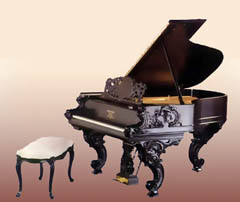
Degrees of Pitch Raise: The technical term for pitch in the piano is Cents. For example, between C and B, a semitone, or half step there are 100 cents. A serious pitch raise is anything more than "25 cents" (a quarter semitone) so the subsequent tuning will be important. After that tuning, the piano generally needs one or less tunings per year. I often choose to not raise pitch if the strings appear rusty, or some have been replaced due to breaking, from age, moisture, heavy playing, etc. String replacement is expensive, as the time it takes to replace a few strings can double the time for servicing, and also new strings will need several additional tunings before they stabilize. They initially need to be muted. I do try most fervently to avoid breaking strings at all times!
More on pitch raises in the Price section below...
Also check out the discussion about 432 vs. 440 Hertz. »
False Beats:
I am often able to remove False Beats that plague many pianos in the alto and soprano sections. These problems occur in the treble areas where the strings are vibrating in the thousands of cycles-per-second and the vibrations can switch between horizontal and vertical modes of direction. Microscopic wear on the bridge pins and capo-bar, bends in the string during installation, micro variations in diameter, all contribute to this annoying phenomenon. Generally micro repositioning of the string on the bridge pin helps. Also helpful is rotating the bridge pin, or introducing some compression on the capo bar or nut.
What to Expect:
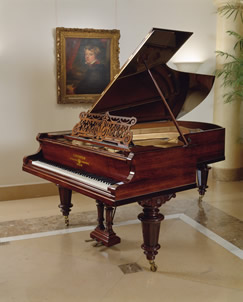
When I show up to take care of your piano, ideally it will have nothing sitting on it, like vases, books, magazines etc. I can always help remove anything that still remains. But I will need to open the lid, remove the music desk and maybe some other parts depending on the piano. It will take me over 2 hours to go over each of the 240+ strings. In addition to getting each string to the right pitch, I test each one to see if it is likely to go flat or sharp. This way I can create the most stable tuning possible.
If any treble strings do need replacing, they can be for $100 for each pair.
If the piano needs cleaning & dusting, I can take care of that with a damp paper towel. More serious cleaning, for example, below the strings in a grand, can be done with a vacuum and several specialized brushes and tools.
For more serious key set works, (white and/or black key replacement, re-bushings, etc) here are some prices. Once there were many Piano Shops in the Bay Area, however, due to the cost of living, these shops are all but history.
Price List »
Prices:
I take into consideration how long since the piano has been tuned,  how far away it is, what other problems might come up and try to be very competitive. I've recently researched other technician's prices, I'm very competitive asking $220 and I generally spend at least two hours creating high quality, stability and accuracy. I can usually address other minor problems if they only take a few more minutes without extra charges, how far away it is, what other problems might come up and try to be very competitive. I've recently researched other technician's prices, I'm very competitive asking $220 and I generally spend at least two hours creating high quality, stability and accuracy. I can usually address other minor problems if they only take a few more minutes without extra charges,
It's important to find out how long a tuner plans to take, as I don't think it's possible to do a really good job in much less than 2 hours except if the piano is so close to perfect that it only needs a few strings adjusted. Many other tuners spend an hour or so and still charge a similar amount.
More on Pitch:
If the piano is 10¢ to 50¢ or more flat [for example F to E is 100¢] if it hasn't been tuned for years or decades, then I need to spend up to 3 or more hours to do a pitch raise + tuning. In this situation I often need to go back over many strings as I move up and down the keyboard. As each string being raised lowers its neighbors 10-25%, getting to A440 takes just the right amount overshooting. And it's not like all the strings are going to be the same amount flat everywhere. Some areas are twice or three times as flat. Keep in mind that an error of 1¢ or 2¢ between the strings in the same note, or octave can be clearly heard, so the precision of setting frequencies and having them stay solid is most critical.
This overall pitch problem increases significantly the newer the piano or the strings.
Brand new pianos should be tuned 3 times for the first year, then 2 times for the next 2. Then once per year. New pianos that have been neglected for 5-10 years are comparable to older ones going for 20-40 years. Rarely does this seem to be the case with the newer pianos I encounter!
The same problem occurs when a string breaks and a new one is installed, this problem requires special treatment if the note is going to be played. The new string is tuned to the next higher note and is silenced with a mute felt for 6-10 months, this rapid conditioning allows the string to then be tuned and played and will only require adjusting occasionally, otherwise it will go extremely flat in just a week!
|
Cities I Service include:
Brisbane, Daly City, South San Francisco, Millbrae, Burlingame, Hillsborough, San Mateo, Belmont, most often in my home city, San Carlos, Redwood City, Atherton, Menlo Park, Palo Alto, & Mountain View. I also service pianos in the South Bay: Cupertino, Campbell, Los Gatos, Sunnyvale, and Santa Clara. Occasionally I will go to the southern East Bay as long as it's not far from the bridges.
|
TOP OF PAGE »

Visit my page MORE ABOUT PIANOS»»
and learn a little of what makes THE PIANO such a special instrument!!
TOP OF PAGE »
Tensions:
At somewhere between 160 to 200 pounds per string,
~~~ with average of 230 strings ~~~
the total tension is between 35,000 - 46,000 pounds.
Pitch Raise:
Tension is proportional to the square of frequency.
So if you change pitch from, say, 440 to 442hz,
then tension changes by the square of that:
(442/440)^2 = 1.0091, or an increase of 0.91%.
So 100lbs would become 100.91lbs.
Or almost a half pound for each hertz
[total # strings range between 220 - 240]
So, lowering from 440 to 432 would
be 8 HZ
About ≈ 4 lbs per string X 230 strings = 800 lbs
which is
around a 2.5 % drop in total tension
|
| |
~~~~~~~~~~~~~~~~~~~~~~~~~~~~~~~~~~~~~~~~~~~~~~~~~~~~~~~~~~~~~~~~~~~~~~~~~~~~~~~~~~~
Sanderson Accu Tuner III Charger:
9V negative on the inside, positive on the outside
9VDC
BayPianoTuner.Com COPYRIGHT © 2022 ALL RIGHTS RESERVED
|


![]()






 I learned the piano craft as an apprentice back in the mid 70's in a prestigious rebuilding shop. I worked there about 2 years under the direction of local
I learned the piano craft as an apprentice back in the mid 70's in a prestigious rebuilding shop. I worked there about 2 years under the direction of local  Piano legend Bob Burton. There I learned all the kinds of repairs, adjustments, complete rebuilding everything from historic nineteenth century antiques to modern top-quality concert grands. Since starting my own business in 1977, I have tuned and serviced all styles and sizes of pianos. I have completely rebuilt and refinished many grands, Steinway, Bechstein and Bösendorfer. I am also one of the few technicians who will work on Square Grands and Birdcages, those now rare antiques that have somehow survived from the 1830′s to the 1890's. No matter what the age, condition or quality of your piano, I always endeavor to make my customers completely happy!
Piano legend Bob Burton. There I learned all the kinds of repairs, adjustments, complete rebuilding everything from historic nineteenth century antiques to modern top-quality concert grands. Since starting my own business in 1977, I have tuned and serviced all styles and sizes of pianos. I have completely rebuilt and refinished many grands, Steinway, Bechstein and Bösendorfer. I am also one of the few technicians who will work on Square Grands and Birdcages, those now rare antiques that have somehow survived from the 1830′s to the 1890's. No matter what the age, condition or quality of your piano, I always endeavor to make my customers completely happy! which is customized for the unique scale of each piano. Normal tunings are guaranteed to last for 6 months. ("Normal" means pianos that were tuned within 2 years, and/or don't need a Pitch-Raise....
which is customized for the unique scale of each piano. Normal tunings are guaranteed to last for 6 months. ("Normal" means pianos that were tuned within 2 years, and/or don't need a Pitch-Raise....  technique to deal with those most neglected pianos that have been unused for decades, and are a note flat. I can do an extreme Pitch-Raise [50-100 cents] with a single tuning all in one pass. I often go over several notes twice but generally get everything within a few cents. This kind of tuning usually takes 3 or more hours. But instead of insisting that the piano needs 2 or more tunings that same day, I can save the second tuning for 3 to 7 months later when the piano will then be settled down enough so that the next tuning can then be quite stable.
technique to deal with those most neglected pianos that have been unused for decades, and are a note flat. I can do an extreme Pitch-Raise [50-100 cents] with a single tuning all in one pass. I often go over several notes twice but generally get everything within a few cents. This kind of tuning usually takes 3 or more hours. But instead of insisting that the piano needs 2 or more tunings that same day, I can save the second tuning for 3 to 7 months later when the piano will then be settled down enough so that the next tuning can then be quite stable.  When that tension exceeds the non-speaking area's tension, and when the friction of the capo bar and bridge give way, then the string will go a little flat each time the note is played loudly. By slightly increasing these non-speaking area tensions, the speaking length will stay much more stable, but will still go flat from the effects of time, metal fatigue, stretching and age.
When that tension exceeds the non-speaking area's tension, and when the friction of the capo bar and bridge give way, then the string will go a little flat each time the note is played loudly. By slightly increasing these non-speaking area tensions, the speaking length will stay much more stable, but will still go flat from the effects of time, metal fatigue, stretching and age.  More on Pitch Raises:
More on Pitch Raises:

 how far away it is, what other problems might come up and try to be very competitive. I've recently researched other technician's prices, I'm very competitive asking $220 and I generally spend at least two hours creating high quality, stability and accuracy. I can usually address other minor problems if they only take a few more minutes without extra charges,
how far away it is, what other problems might come up and try to be very competitive. I've recently researched other technician's prices, I'm very competitive asking $220 and I generally spend at least two hours creating high quality, stability and accuracy. I can usually address other minor problems if they only take a few more minutes without extra charges,

